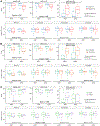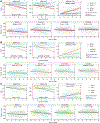TDP-43 Pathology Exacerbates Cognitive Decline in Primary Age-Related Tauopathy
- PMID: 35696592
- PMCID: PMC9391297
- DOI: 10.1002/ana.26438
TDP-43 Pathology Exacerbates Cognitive Decline in Primary Age-Related Tauopathy
Abstract
Objective: Primary age-related tauopathy (PART) refers to tau neurofibrillary tangles restricted largely to the medial temporal lobe in the absence of significant beta-amyloid plaques. PART has been associated with cognitive impairment, but contributions from concomitant limbic age-related TDP-43 encephalopathy neuropathologic change (LATE-NC) are underappreciated.
Methods: We compare prevalence of LATE-NC and vascular copathologies in age- and Braak-matched patients with PART (n = 45, Braak stage I-IV, Thal phase 0-2) or early stage Alzheimer disease neuropathologic change (ADNC; n = 51, Braak I-IV, Thal 3-5), and examine their influence on clinical and cognitive decline.
Results: Concomitant LATE-NC and vascular pathology were equally common, and cognition was equally impaired, in PART (Mini-Mental State Examination [MMSE] = 24.8 ± 6.9) and ADNC (MMSE = 24.2 ± 6.0). Patients with LATE-NC were more impaired than those without LATE-NC on the MMSE (by 5.8 points, 95% confidence interval [CI] = 3.0-8.6), Mattis Dementia Rating Scale (DRS; 17.5 points, 95% CI = 7.1-27.9), Clinical Dementia Rating, sum of boxes scale (CDR-sob; 5.2 points, 95% CI = 2.1-8.2), memory composite (0.8 standard deviations [SD], 95% CI = 0.1-1.6), and language composite (1.1 SD, 95% CI = 0.2-2.0), and more likely to receive a dementia diagnosis (odds ratio = 4.8, 95% CI = 1.5-18.0). Those with vascular pathology performed worse than those without on the DRS (by 10.2 points, 95% CI = 0.1-20.3) and executive composite (1.3 SD, 95% CI = 0.3-2.3). Cognition declined similarly in PART and ADNC over the 5 years preceding death; however, LATE-NC was associated with more rapid decline on the MMSE (β = 1.9, 95% CI = 0.9-3.0), DRS (β = 7.8, 95% CI = 3.4-12.7), CDR-sob (β = 1.9, 95% CI = 0.4-3.7), language composite (β = 0.5 SD, 95% CI = 0.1-0.8), and vascular pathology with more rapid decline on the DRS (β = 5.2, 95% CI = 0.6-10.2).
Interpretation: LATE-NC, and to a lesser extent vascular copathology, exacerbate cognitive impairment and decline in PART and early stage ADNC. ANN NEUROL 2022;92:425-438.
© 2022 American Neurological Association.
Conflict of interest statement
Potential Conflicts of Interest:
All authors have nothing to report.
Figures




Similar articles
-
Cognitive and Neuropsychological Profiles in Alzheimer's Disease and Primary Age-Related Tauopathy and the Influence of Comorbid Neuropathologies.J Alzheimers Dis. 2023;92(3):1037-1049. doi: 10.3233/JAD-230022. J Alzheimers Dis. 2023. PMID: 36847012 Free PMC article.
-
Association of Cognition and Dementia With Neuropathologic Changes of Alzheimer Disease and Other Conditions in the Oldest Old.Neurology. 2022 Sep 5;99(10):e1067-e1078. doi: 10.1212/WNL.0000000000200832. Neurology. 2022. PMID: 35705500 Free PMC article.
-
Characterizing Limbic-Predominant Age-Related TDP-43 Encephalopathy Without Alzheimer's Disease and Lewy Body Dementia in the Oldest Old: A Case Series.J Alzheimers Dis. 2023;96(1):113-124. doi: 10.3233/JAD-230238. J Alzheimers Dis. 2023. PMID: 37742640 Free PMC article.
-
LATE, Hippocampal Sclerosis, and Primary Age-related Tauopathy.Continuum (Minneap Minn). 2024 Dec 1;30(6):1726-1743. doi: 10.1212/CON.0000000000001499. Continuum (Minneap Minn). 2024. PMID: 39620841 Review.
-
Neuropathology of Alzheimer's Disease.Neurotherapeutics. 2022 Jan;19(1):173-185. doi: 10.1007/s13311-021-01146-y. Epub 2021 Nov 2. Neurotherapeutics. 2022. PMID: 34729690 Free PMC article. Review.
Cited by
-
TDP-43 Proteinopathy and Tauopathy: Do They Have Pathomechanistic Links?Int J Mol Sci. 2022 Dec 12;23(24):15755. doi: 10.3390/ijms232415755. Int J Mol Sci. 2022. PMID: 36555399 Free PMC article. Review.
-
TDP-43 Is Associated with Subiculum and Cornu Ammonis 1 Hippocampal Subfield Atrophy in Primary Age-Related Tauopathy.J Alzheimers Dis. 2024;99(3):1023-1032. doi: 10.3233/JAD-240136. J Alzheimers Dis. 2024. PMID: 38728190 Free PMC article.
-
Disentangling and quantifying the relative cognitive impact of concurrent mixed neurodegenerative pathologies.Acta Neuropathol. 2024 Mar 23;147(1):58. doi: 10.1007/s00401-024-02716-y. Acta Neuropathol. 2024. PMID: 38520489 Free PMC article.
-
Cognitive decline in community-dwelling older persons with primary age-related tauopathy: role of anatomical location of tangles and other co-existing brain pathologies.Acta Neuropathol. 2025 Jul 24;150(1):8. doi: 10.1007/s00401-025-02916-0. Acta Neuropathol. 2025. PMID: 40705123
-
The relationship between hippocampal amyloid beta burden and spatial distribution of neurofibrillary degeneration.Alzheimers Dement. 2023 Jul;19(7):3158-3170. doi: 10.1002/alz.12966. Epub 2023 Feb 4. Alzheimers Dement. 2023. PMID: 36738450 Free PMC article.
References
-
- Nelson PT, Abner EL, Schmitt FA, et al. Brains with medial temporal lobe neurofibrillary tangles but no neuritic amyloid plaques are a diagnostic dilemma but may have pathogenetic aspects distinct from Alzheimer disease. Journal of neuropathology and experimental neurology 2009;68(7):774–84. - PMC - PubMed
-
- Ikeda K, Akiyama H, Arai T, et al. Clinical Aspects of ‘Senile Dementia of the Tangle Type’ – A Subset of Dementia in the Senium Separable from Late-Onset Alzheimer’s Disease. Dement Geriatr Cogn 1999;10(1):6–11. - PubMed
-
- Itoh Y, Yamada M, Yoshida R, et al. Dementia Characterized by Abundant Neurofibrillary Tangles and Scarce Senile Plaques: A Quantitative Pathological Study. Eur Neurol 1996;36(2):94–97. - PubMed
-
- Bancher C, Jellinger KA. Neurofibrillary tangle predominant form of senile dementia of Alzheimer type: a rare subtype in very old subjects. Acta Neuropathol 1994;88(6):565–570. - PubMed

